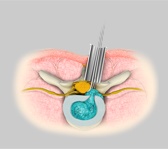Minimally Invasive Spine Surgery

MISS is the latest advanced technology available to perform spinal surgeries through small, less than one-inch-long, incisions. It involves the use of special surgical instruments, devices and advanced imaging techniques to visualize and perform the surgery through such small incisions. MISS is aimed at minimising damage to the muscles and surrounding structures. MISS possesses numerous benefits over the traditional spine surgery that includes:
- Small surgery scars
- Reduced risk of infections
- Less blood loss during the surgery
- Less post-operative pain
- Quicker recovery
- Shorter hospital stay
- Quicker return to work and normal activities
With advances in technology, a number of spine surgeries can be performed through a minimally invasive approach including anterior cervical discectomy and fusion (ACDF), kyphoplasty, intradiscal electrothermal annuloplasty (IDET), posterior cervical laminectomy and fusion, anterior lumbar interbody fusion (ALIF), posterior lumbar interbody fusion(PLIF), transforaminal lumbar interbody fusion(TLIF), axial lumbar interbody fusion(AxiaLIF) and direct lateral lumbar interbody fusion (DLIF).
Selection of patients for minimally invasive surgery
Minimally invasive surgery is suitable only for selected patients. Thus before the surgery, the patient’s medical history and various diagnostic tests, such as X-rays or other imaging tests, are used to ascertain the underlying spinal conditions causing pain and other associated symptoms. The current health status of the patient is also evaluated through blood tests and other specialized tests, for diseases such as diabetes, heart disease and osteoporosis. The decision of performing the surgery through a minimally invasive approach is decided by the surgeon based on their experience and the benefits to the patient as compared to the traditional open spine surgery.
The surgeon explains the surgery and its benefits along with the possible risks to the patient.
Risk and Complications
The risks and complications of the surgery may include infection, bleeding, nerve injury, or spinal cord injury. Complications due to general anaesthesia may also occur.
How is minimally invasive surgery done?
Minimally invasive spine surgery is done through small incisions. Segmental tubular retractors and dilators are then inserted through these small incisions to retract muscles and provide access to the spine by creating a working channel for the surgery. This minimises the damage to the muscles and soft tissues and decreases the blood loss during the surgery. An endoscope is inserted through one of the incisions to provide images of the operation field, on the monitor in the operation room. The surgery is done with special surgical instruments passed through the working channel. Sometimes surgical microscopes may also be used to magnify the visual field. The tissues fall back in place, as the various instruments are withdrawn. The incision is then closed and dressed.
Contact your surgeon for any unanswered queries on minimally invasive spine surgery.
Patient Testimonials
- Romana Vanova: "The surgery went very well, and we removed the entire calcified disc. On day one she was sitting up, she said she could feel her legs for the first time in five months."
- Laura Welch: "I had immediate pain relief as soon as I woke up from surgery. I walked out of hospital unaided. It's been 4 weeks now and I'm doing really great."
- Charles Slater: "At my first appointment with Mr Pal in December 2016 he gave me hope because he said that, subject to me passing various medical tests including angiograms, he was willing to operate."
- Calum Currie: "Having experienced debilitating sciatica, numbness and burning in my legs, along with serious back pain for many years, I had also received two previous decompression surgeries before finally coming down from Scotland to Leeds to find Mr Pal for help."
- Krystyna Ellis: "I have endured back pain since 2007 and have had four previous spinal surgeries. It was expected that in time I may become paralysed due to pressure by a big disc on my thoracic spinal cord."
- Matthew Anderson: "He has improved my quality of life, for which I will always be extremely grateful."

